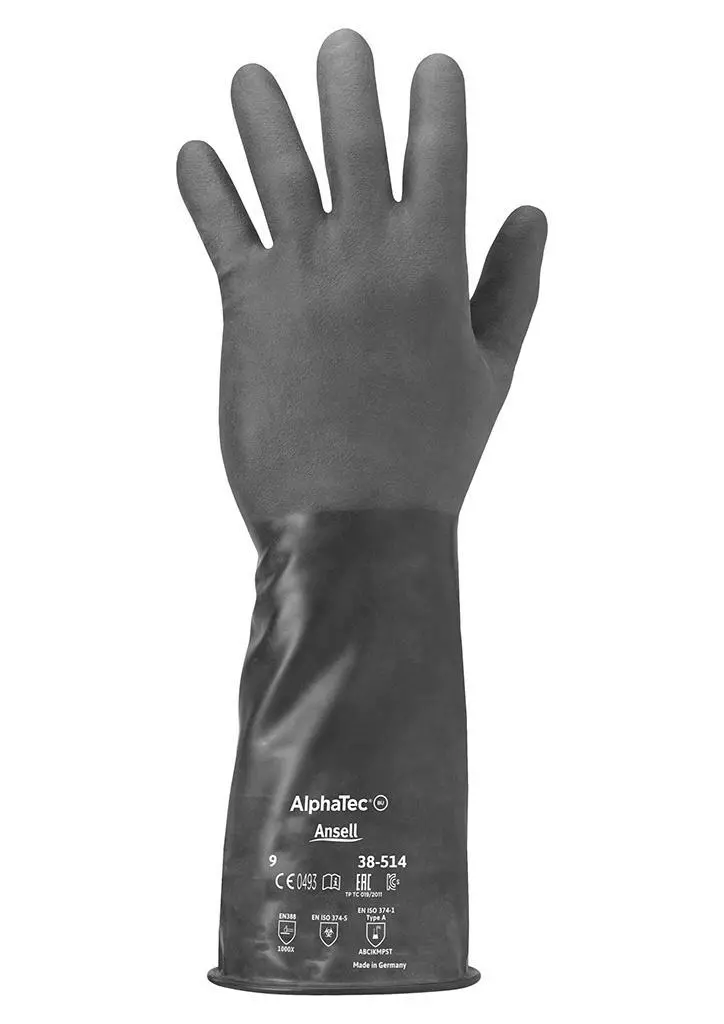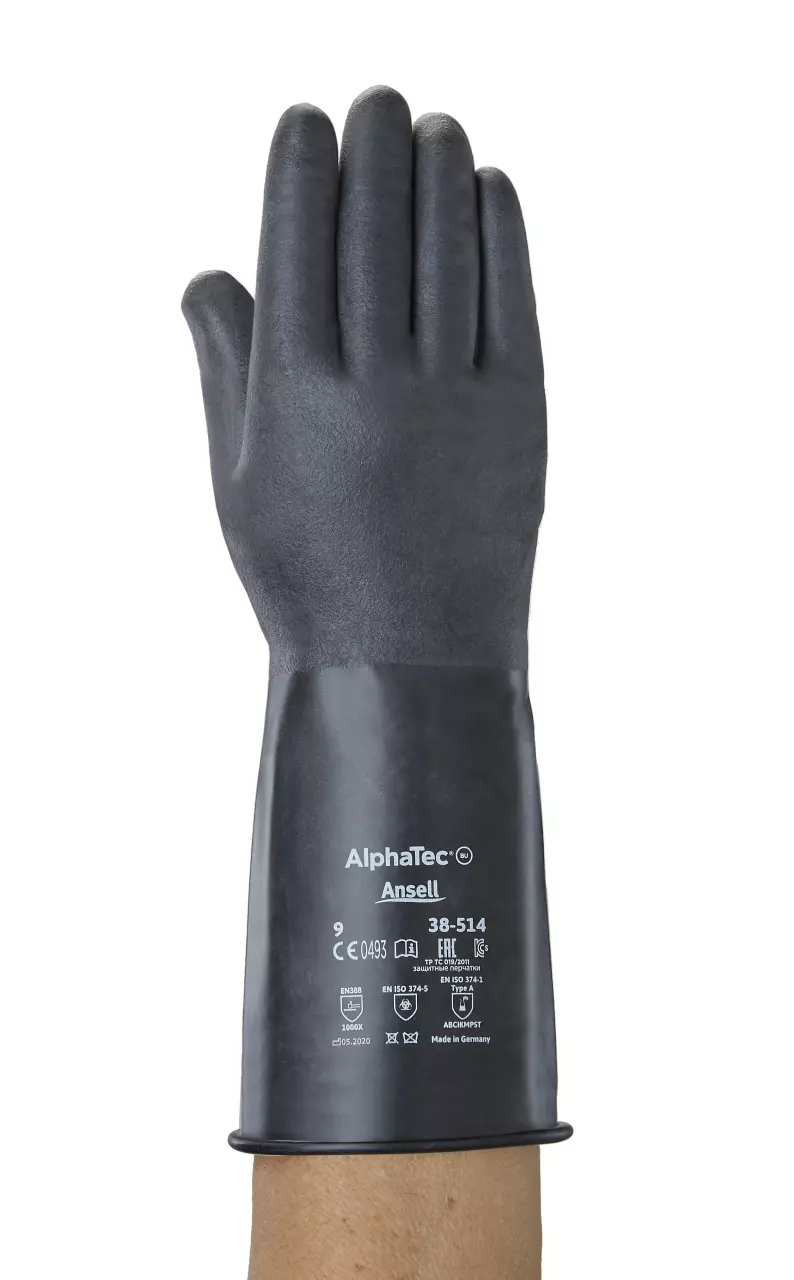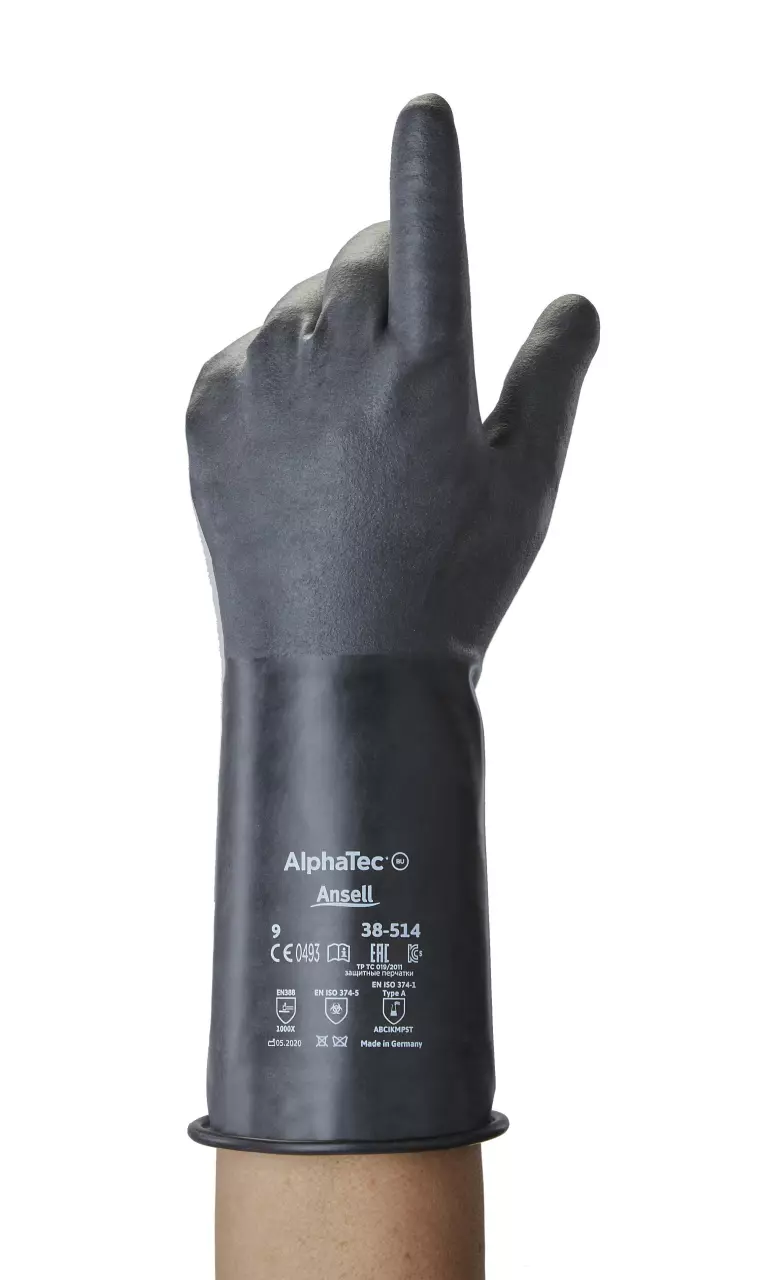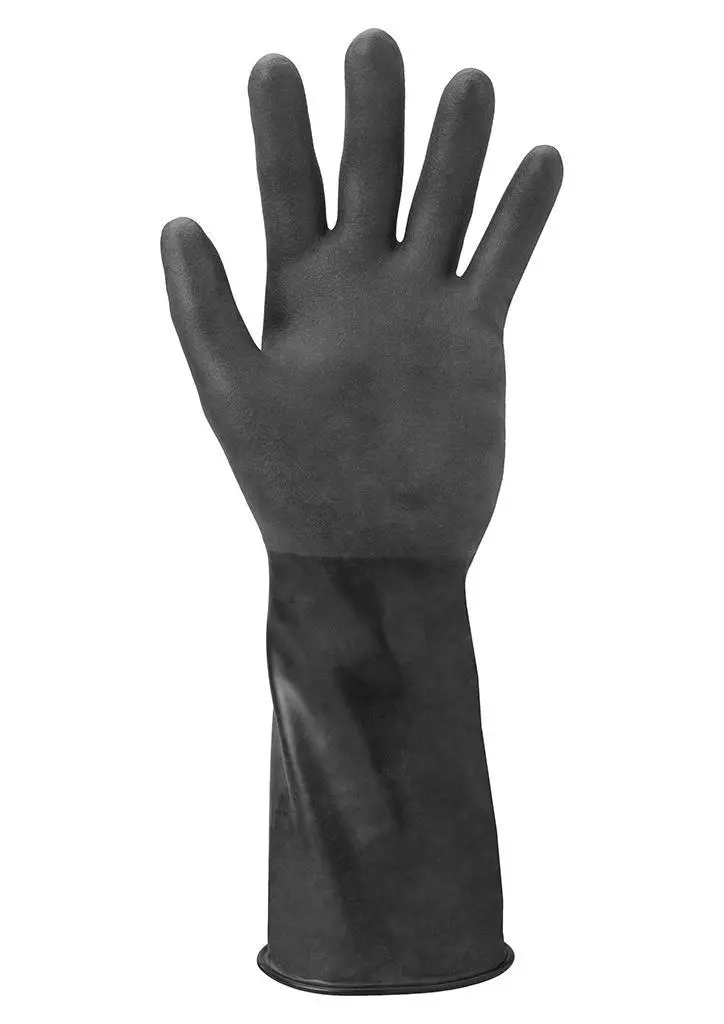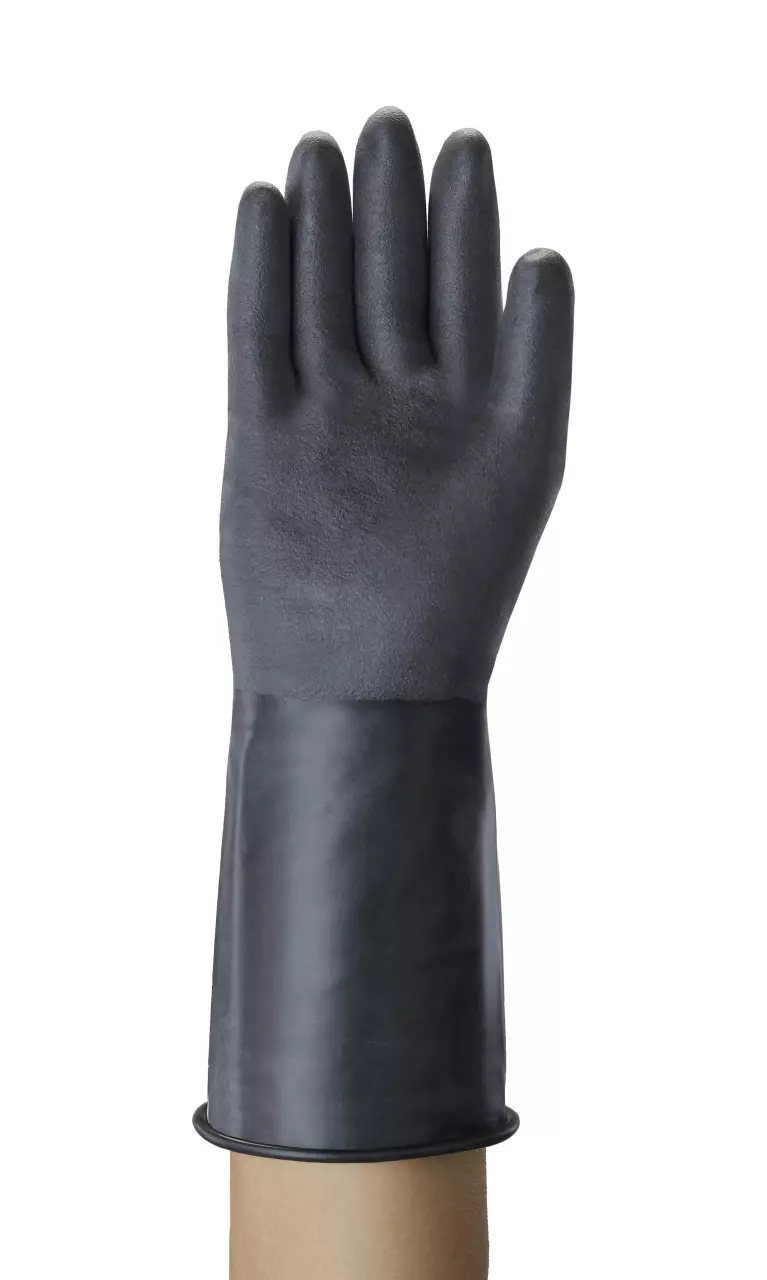Ansell AlphaTec 38-514
Ansell
visit storeProduct description
Description
Advanced defenses: AlphaTec® 38-514 butyl gloves offer superior protection against highly aggressive chemicals, including aldehydes, ketones, esters and concentrated mineral acids
Reduced allergy risks: As they are free from latex proteins, these hand protection gloves present no risk to wearers with latex allergies
Improved ergonomics: Designed for comfort, AlphaTec® 38-514 industrial gloves feature a naturally curved shape and a soft feel, protecting hands while facilitating donning and doffing
Enhanced flexibility: Their soft butyl formulation also enhances their flexibility and dexterity
Strengthened grip: In addition, these butyl gloves feature a rough finish around the hand section, enhancing grip and ensuring safer handling
Recommended for
Equipment repair & maintenance
Loading and unloading of proces equipment
Handling incoming goods
Filling, blending and charging of raw materials
Transferring liquids and solids
Opening and draining pumps valves or lines
Transferring liquids and solids between vessels and tanks and process equipment
Supervision of running operation
Charging and blending raw materials
Opening furnaces draining pumps valves or lines and crackers BTX process
Cleaning furnaces, distillation pumps, valves or lines and crackers BTX process
Unexpected leakages spills or other releases
Product Details
Antistatic : Yes En1149
Available Sizes : 7, 8, 9, 10, 11
Coating Color : Black
Coating Material : Butyl Polymer
Construction : Unsupported
Cuff Style : Beaded
Grip Design : Rough Finish
Latex Free : Yes
Silicone Free : Not Tested
Length (Mm/Inches) : 350 / 13.8
Palm Thickness (Mm/Mil) : 0.35 / 13.8
The design of the wrist area that secures the glove and prevents debris entry. Different styles offer varying levels of adjustability, protection, and comfort.
Measures how far the glove extends up the arm, determining protection coverage. Longer lengths shield forearms from chemicals, heat, and other workplace hazards.
The visual appearance that enhances workplace safety through visibility, identification, and hazard awareness while allowing for team differentiation and brand recognition.
Defines the texture pattern on contact surfaces that affects traction, control, and handling ability in various work conditions like wet, oily, or dry environments.
Offers enhanced forearm coverage, protecting against splashes and contaminants. Ideal for tasks requiring greater protection beyond the wrist area.
Provides complete hand coverage, shielding fingers from hazards. Offers maximum protection and warmth, ideal for demanding tasks and environments.
Suited for various tasks, these gloves offer essential protection and flexibility. A practical choice providing comfort and durability for everyday use.
- Antimicrobial Protection
- Hand Protection
- Electrical Protection
Request a free sample
Test first and buy later. Visit any product page to request your free sample.
Standards and labels
Test results
General Requirements GuideEN ISO 21420:2020 is a standard that outlines general requirements and guidelines for protective gloves, aiming to ensure their quality, performance, and suitability for various applications. When a product meets the requirements outlined in the General Requirements section of EN ISO 21420:2020, it signifies that the gloves comply with fundamental quality and performance criteria, including factors such as size, fit, ergonomics, and dexterity. The practical implications of this compliance are significant, as it assures users of the gloves' basic functionality and suitability for general hand protection purposes across a range of industries and applications. The test method involves evaluating various aspects of the gloves, including dimensions, construction, materials, and labeling, to ensure conformity with the specified requirements. Compliance with these general requirements enhances user confidence in the protective gloves' reliability and effectiveness, promoting workplace safety and facilitating compliance with regulatory standards.
EN ISO 374-1:2016 is a standard that defines the performance requirements for gloves that protect against chemicals and microorganisms. The standard specifies the design, materials, and testing requirements for gloves to protect against chemicals and microorganisms. Possible test results include measurements of the gloves' permeation resistance, degradation, and penetration. It also includes the safety and functionality requirements for gloves.
Test results
Specified Requirements Type AEN 388:2016 is a European standard for measuring the performance of protective gloves against mechanical risks (abrasion, cut, tear, and puncture). The standard includes test methods and performance requirements for gloves to be considered compliant. Test results are reported using a series of four numbers, each representing the performance level achieved in one of the tests.
Test results
Tear Resistance Level 0The Tear Resistance Level 0 in the EN 388:2016 standard refers to the lowest classification for tear resistance performance. It indicates that the material did not reach the minimum threshold required to attain a higher performance level in the tear resistance test. In assessing this result under EN 388:2003, the test involves applying a force to a test piece of the material until it tears. This specific test measures how much force the material can withstand before it tears, and a Level 0 result shows very minimal or no resistance to tearing. For procurement professionals dealing with safety gloves or similar protective materials, understanding that a tear resistance rating of Level 0 suggests that these products are not suitable for working environments where resistance to tearing is critical.
Puncture Resistance Level 0EN 388:2016 specifies safety glove standards, including puncture resistance. The test result Level 0 in puncture resistance indicates that the product does not meet the minimal requirements set by the standard for protecting against punctures. The test method used involves using a standardized stylus with a specified force applied to the glove material. This is measured by the amount of force needed before the stylus punctures through the glove material. A Level 0 result signifies that the glove failed to provide any standardized level of protection during the testing procedure, which means it is not suitable for environments where puncture resistance is required for safety purposes .
Cut Resistance, ISO 13997 Level XThe standard EN 388:2016, specifically its segment referring to ISO 13997 test, is designed to assess the cut resistance of materials used in protective gloves. A result denoted as 'Level X' means that test is not performed and the cut resistance of the product cannot be guaranteed.
Abrasion Resistance Level 1In the EN 388:2016 standard, the Abrasion Resistance result Level 1 signifies that the tested gloves or protective materials can withstand 100 cycles of sandpaper abrasion under pressure, before developing a hole. This is considered the lowest performance level in abrasion resistance according to the standard. Generally, Level 1 abrasion resistance would be underperforming for tasks that involve frequent contact with abrasive surfaces, and might be more suitable for situations where light abrasion is the primary risk. Higher numbers (up to 4) in this test indicate stronger abrasion resistance.
Cut Resistance, Coup Test Level 0The EN 388:2016 standard specifies requirements and test methods for protective gloves in relation to physical and mechanical aggressions due to abrasion, blade cut, tear, puncture, and impact resistance. A Cut Resistance Level 0 result in this standard implies that the protective gloves under assessment offer very minimal to no protection against cutting hazards. The Coup Test, utilized to determine this result, involves rotating a circular blade under constant pressure against the glove material until it is cut through. This test specifically assesses how well glove materials can withstand cutting forces from a sharp, circular blade. For procurement professionals, this result indicates that gloves with a Cut Resistance Level 0 are unsuitable for environments where there is a risk of hand injuries from sharp objects as they provide the lowest level of cut resistance under EN 388:2016.
Test results
Micro-organisms Bacteria & FungiEN ISO 374-5:2016 is a standard that defines the requirements for gloves to protect against dangerous chemicals and micro-organisms, including bacteria and fungi. The test results indicating protection against Bacteria & Fungi confirm that the gloves have effectively passed the necessary evaluations to guard against these types of micro-organisms. The test method used assesses the glove's resistance to penetration and permeation by micro-organisms. The glove material undergoes specific challenges designed to ensure that pathogens such as bacteria and fungi cannot penetrate or permeate through the material under standard testing conditions. Practical implications of these results include assurance that gloves certified under this standard provide health professionals and others exposed to biohazards with a reliable barrier against potential infections caused by bacteria and fungi, which is crucial for both healthcare settings and lab environments.
REACH stands for "Registration, Evaluation, Authorisation and Restriction of Chemicals" it is a regulation of the European Union that governs the registration, evaluation, authorization, and restriction of chemicals. The REACH regulation aims to ensure that the chemicals used in Europe are safe for human health and the environment. The regulation applies to all chemical substances, whether they are used in industrial processes or in everyday products such as cleaning products, paints, and cosmetics. Companies that manufacture, import or use chemicals in the EU must register the chemicals they produce or import, provide safety information and communicate the risks associated with the chemicals. This information will be used to assess the risks and determine if any further action is needed to protect human health and the environment.
CE Marking is a label that shows a product meets certain safety and environmental standards set by the European Union. To get the CE Marking, a company must test and certify their product meets these standards. CE Marking is required for many products sold in the EU, including electronics, machinery, toys and medical devices. It helps ensure that products are safe for consumers and the environment, and allows for easy trade within the EU.
PPE stands for "personal protective equipment." PPE Category 3 refers to equipment that is complex and provide the highest level of protection such as powered respirators, SCBA, and full body suits. In Europe, PPE Category 3 must meet certain safety standards set by the European Union, which means that it must be designed and manufactured to protect the user without causing harm. Companies that make or sell PPE must prove that it meets these standards. They also must have a quality management system in place, have to be audited regularly by a notified body and have to have a technical documentation.
Ansell delivery terms
Free delivery for all Ansell products
15 824,30 kr
Price per 36 packages (36 pairs)
439,56 kr / pair
Free delivery
A carton contains 36 packages (36 pairs)
Need larger quantities?
Other products you may like
Recently viewed
Need help?
Get help from our experts
Other products you may like
Similar products you may like
Recommended for you
Ansell
Delivery time: 7 business days
Orders from 10 000,00 €
Supplier shipping fee 60,00 €
Free shipping on orders over 1 650,00 €



Find +150,000 products from hundreds of brands
Autonomous sourcing platform
The most efficient way to source and order supplies for your operations
Sourcing
Ordering
List products you’re looking for and we’ll find the best products and prices for you – all for free.
Need help?
Get help from our experts
